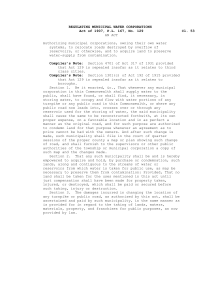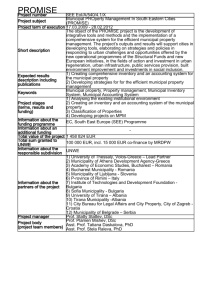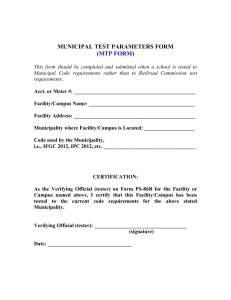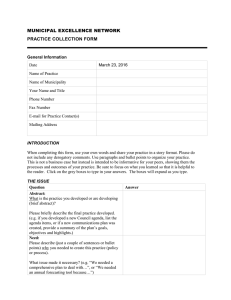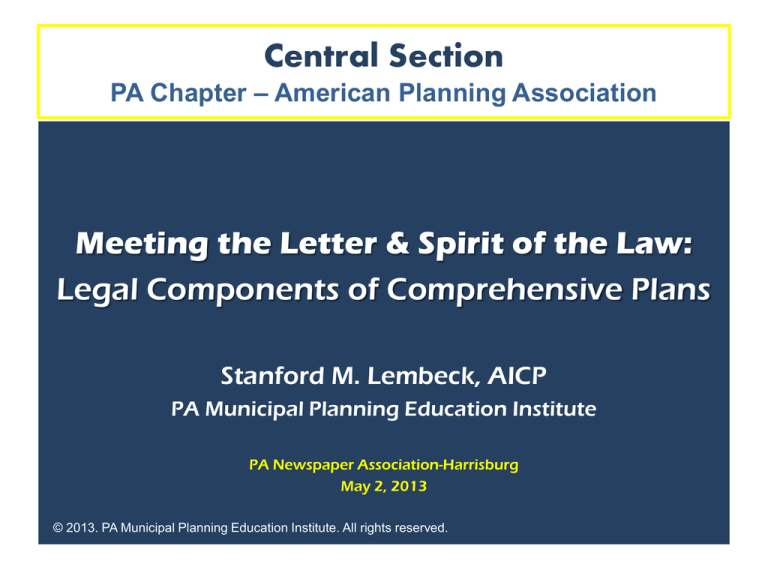
Central Section
PA Chapter – American Planning Association
Meeting the Letter & Spirit of the Law:
Legal Components of Comprehensive Plans
Stanford M. Lembeck, AICP
PA Municipal Planning Education Institute
PA Newspaper Association-Harrisburg
May 2, 2013
© 2013. PA Municipal Planning Education Institute. All rights reserved.
CENTRAL SECTION WORKSHOP
Workshop Goals
To understand the legal connection between
comprehensive plans and the Pennsylvania
Municipalities Planning Code.
And other laws.
What’s this Comprehensive Plan
Thing?
An “article of faith” for planners
Richard Hedman & Fred Bair, Jr. And on the Eighth Day
About COMPREHENSIVE PLANS
It’s an “article of faith” for planners. It’s what we do.
It’s called “comprehensive,” but can it really be? (You don’t
know what you don’t know)
There’s no definition of “comprehensive plan” in the MPC.
It’s kind of defined by what goes into it.
People say: It has no “teeth.” It can’t force (coerce) actions or
behavior.
A “Toothless” Plan?
a 1971 court decision
• A comprehensive plan and a zoning ordinance are two
separate tools to be used in the statutory scheme of
municipal land utilization.
• A comprehensive plan is an overall guide to land utilization
and to meeting the needs and desires of a community
whereas a zoning ordinance regulates the land use as
recommended by the plan.
• A comprehensive plan is abstract and recommendatory;
a zoning ordinance is specific and regulatory.
Morelli et al v Boro of St. Marys et al
1 Commonwealth Ct. 612 (1971)
But is a Comprehensive Plan
really “toothless?
§ 503. Contents of Subdivision & Land Development Ordinance.
The SALDO may include, but need not be limited to:
(2) Provisions for insuring that:
(i) the layout or arrangement of the subdivision or land
development shall conform to the comprehensive plan
and to any regulations or maps adopted in furtherance
thereof:
(ii) streets in and bordering a subdivision or land development shall be coordinated, and be of such widths and
grades and in such locations as deemed necessary to
accommodate prospective traffic and facilitate fire
protection:
(iii) drainage rights of way; (iv) reservations for public grounds
by developers; (iv) land subject to flooding, subsidence, etc.
Comprehensive Plan as “Threshold”
• 1006-A: Judicial Relief (b.1) Municipalities with adopted
multimunicipal comprehensive plan- if zoning validity is
challenged-may be entitled to “regional land use sharing”
• VIII-A: Joint Municipal Zoning 801-A (b) Joint municipal
zoning ordinance shall be based on an adopted joint
municipal comprehensive plan
• §503(11) Public dedication of land for…recreation facilities based
on formally adopted recreation plan
• §501-A. Purposes Power to enact “municipal capital
improvement” granted to municipalities or counties with an
adopted comprehensive plan, SALDO and zoning
More about COMPREHENSIVE PLANS
It’s an “article of faith” for planners.
It’s called “comprehensive,” but can it really be? (You don’t
know what you don’t know)
There’s no definition of “comprehensive plan” in the MPC.
It’s kind of defined by what goes into it.
It has no “teeth.” It can’t force (coerce) actions or behavior.
They’re costly.
After they’re finished nothing much is done with them.
Implimenting the Plan
Richard Hedman & Fred Bair, Jr. And on the Eighth Day
More about COMPREHENSIVE PLANS
It’s an “article of faith” for planners.
It’s called “comprehensive,” but is it really?
There’s no definition of it in the MPC.
It’s kind of defined by what goes into it.
It has no “teeth.” It can’t force (coerce) actions or behavior. (So what’s
the point?)
They’re costly.
After they’re finished not much is done with them.
There’s no “user guide” in the MPC for comprehensive plans. What
do we do with it? How are we supposed to use it?
But, there’s a whole Article in the MPC on it. Why?
Does a comprehensive plan
have any intrinsic value or
purpose of its own?
(aside from being a basis for land use
regulations)
The MPC: Articles
1
2
General Provisions
Planning Agencies
3
Comprehensive Plan
4
5
Official Map
Subdivision & Land
Development
5A Municipal Capital Improvement (trans Impact fee)
6
7
Zoning
Planned Residential
Development (PRD)
7A Traditional Nbhd Dev (TND)
8A Joint Municipal Zoning
9
Zoning Hearing Board &
Other Admin Procedures
10 Appeals to Court
11 Intergovernmental Cooperative Planning & Implementation Agreements
11A Wastewater Processing
Cooperative Planning
There’s no definition of
“comprehensive plan”
And, there’s no “user guide” to
how to use it
Article III: Comprehensive Plan
§301. Preparation of Comprehensive Plan
(Current MPC)
(a) The municipal, multimunicipal, county
comprehensive plan,
consisting of maps, charts
and textual matter, shall
include, but need not be
limited to, the following
related basic elements:
(Original 1968 MPC)
The planning agency shall prepare
and maintain a comprehensive plan
for the development of the
municipality.
The comprehensive plan, consisting
of maps, charts and textual matter,
shall indicate the recommendations of
the planning agency for the continuing
development of the municipality.
The comprehensive plan shall
include, but need not be limited to, the
following related basic elements:
Comprehensive Plan basic elements
(original 1968 MPC)
1. A statement of objectives
2. A plan for land use
3. A plan for movement of
people and goods
4. A plan for community
facilities and utilities
5. A map or statement
relating proposed
development to adjacent
municipalities and areas
(current MPC)
1 Statement of objectives
2 Plan for land use
3 Housing needs plan
4 Transportation plan
5 Community facilities plan
6 Plan elements relationships
7 Implementation strategies
8 Compatibility with others
9 Plan to protect natural resources
10 Water supply plan
Pennsylvania Municipal Planning Education Institute
Course in Community Planning
♦ PA Municipalities Planning Code
♦ Planning Agencies
♦ The Comprehensive Plan
purpose and components of plans
planning agency’s role
joint planning & intergovernmental cooperation
plan updates and consistency
♦ Plan Implementation
♦ Effective Planning Commissions
How to use a Comprehensive Plan?
An official statement of
the governing body’s
future planning goals
An overall view of how
the many pieces of the
community should work
Comprehensive
Comprehensive
Plan
Plan
A tool for evaluating
proposed projects (does
it move the plan forward?)
Serves as a guide for the
future development of
the municipality
What is a Comprehensive Plan?
• A reference point for the governing body’s
development and budget decisions; capital
improvements priorities and timing
• A guide for private-sector decision-making
• Provides guidelines for planning commission reviews
• I t’s the basis for land use regulations-provides the
rationale for regulating private property
Capital Improvements Budget
CAPITAL IMPROVEMENTS
6 YEAR BUDGET
EST.
COST*
RANK
2013
2014
2015
2016
2017
2018
Storm Sewers
2,100.
1
225
225
225
225
225
225
Sanitary Sewers
2,100.
2
225
225
225
225
225
225
Well site acquisition
1,000.
6
500
500
Fire Equipment
400.
3
Parkland acquisition
250.
5
Park development
1,750.
7
500
500
500
Street improvements
3,000.
4
300
300
300
Mun Bldg renovation
1,500.
8
500
500
TOTAL
$12,100
1,750
1,750
PROJECTS
200
200
75
300
950
300
1,250
175
300
1,425
1,750
* Est. costs in 000’s of dollars. Funding sources TBD: taxes, borrowing, grants impact fees
What the Comprehensive Plan looks at
(MPC §301.2- Surveys by planning agency)
Housing
Economic
Demographic
Amount-Type-LocationInterrelationships of
Land Uses
characteristics
and trends
Natural
Historic
Cultural
resources
Natural Features
affecting development
General location
& extent of
Transportation
Community Facilities
Prospects for
future growth
The key to comprehensive planning-
Asking the right questions
• What are your community’s assets and
limitations --now and in the future?
• Will the future be like the past: is the past
the best guide to your community’s
future?
• What is the population structure: is it
renewing; is it declining? flat?
Asking the right questions
• What does the community lack now that it
should have or needs; what about its future
needs?
• Do some current services and facilities have
excess capacity; are some at or near their
limits and need renovation or expansion? Will
some new facilities be needed?
• Realistically, what things can your municipality
control; what things are beyond its control?
The Plan-Making Process
A “plan” is the solution to a problem
• Start with a question/problem
• Define it
• Gather data (redefine the problem if needed)
• Decide: what would a good solution (result) look like
• Select the solution (plan)
• Do it (who, what, when, how, how much)
Reminder: start the planning with a question, not a conclusion
Make plans to solve problems
• Our municipality has excess water and sewer
capacity? What opportunities do we have for
better utilization? Who should we work with?
• Our greatest asset is the housing supply. Can we
make it more attractive to young families? How?
Are additional neighborhood amenities needed?
• Long-term community sustainability is a concern. The
population is aging. What actions/policies/
programs could be used to modify the trend?
Comprehensive Planning
and
Marcellus Impact Fees
Authorized Uses of Impact Fees
• Construction/reconstruction,
repair & maintenance of roads,
bridges, public infrastructure
• Construction, repair and maintenance of water, stormwater &
sewer systems
• Emergency preparedness &
public safety: law enforcement,
fire services, others
• Environmental programs: trails,
parks, recreation,open space,
floodplain mgt, ag pres, etc.
• Preservation/reclamation of
surface & subsurface waters &
•
•
•
•
•
•
•
•
water supplies
Affordable housing
Records management, GIS
Delivery of social services
Judicial services
Career & technical centers
Establishment of a capital
reserve account
Local or regional planning
initiatives under the MPC
Tax reductions
Capital Improvements Budget
CAPITAL IMPROVEMENTS
6 YEAR BUDGET
EST.
COST*
RANK
Storm Sewers
.
1
Sanitary Sewers
.
2
Well site acquisition
.
6
Fire Equipment
.
3
Trails, open space
.
5
Bridge repairs
.
7
PROJECTS
2014
2015
2016
2017
2018
4
Road improvements
Affordable housing
2013
.
8
* Est. costs in 000’s of dollars. Funding sources TBD: taxes, borrowing, grants impact fees
Comp Plan Tools
• Power of Persuasion
• Information
• Power of the Purse
(public investment)
• Tax Policies
• Subsidies and Incentives
Adopted Comprehensive Plan
(§ 303/304/305)
Comprehensive Plan Adoption
• The governing body of municipalities may adopt and
amend comprehensive plans as a whole or in part
• Counties must prepare and adopt a comprehensive
plan (301.4)
• Adoption of a comprehensive plan is by resolution of
the governing body
• Adoption “ties” the municipality to its comp plan
§303: Legal Status of Comprehensive Plan
Within the Jurisdiction that Adopted the Plan
• Governing Body, its departments, agencies, appointed
authorities shall
• submit proposed actions for review and recommendations
by the planning agency
• when the proposed action relates to: location, opening,
demotion, expansion, etc. of streets, public grounds, public
structures, water line, sewer line, treatment facility
• Planning Agency’s written recommendations in 45 days
whether proposed action is in accordance with the formally
adopted comprehensive plan
• No action of the governing body is invalid or subject to
challenge if proposed action is inconsistent with comp plan
Definition of “Public Grounds”
§107(a) Public Grounds includes:
(1) Parks, playgrounds, trails, paths and other
recreational and other public areas;
(2) Sites for schools, sewage treatment, refuse disposal
and other publicly owned or operated facilities, and
(3) Publicly owned or operated scenic and historic sites.
§304: Legal Status of County Comprehensive Plan
Within Municipalities
• Following adoption of a comprehensive plan by a county
• Any proposed action of the governing body of a municipality,
its departments, agencies and appointed authorities shall be
submitted to the county planning agency for review
• when the proposed action relates to: location, opening,
demotion, expansion, etc. of streets, public grounds, public
structures, water line, sewer line, treatment facility
• County planning agency’s recommendations in 45 days to
governing body of municipality
• If county planning agency fails to act in timely fashion the
municipal governing body may act without it.
§305: Legal Status of Comprehensive Plans
Within School Districts
• Following adoption of a comprehensive plan by a municipality
or county
• any proposed action of the governing body of a school district
located within the municipality or county
• relating to: location, demolition, removal, sale or lease of any
public school district structure or land shall be submitted to
• municipal or county planning agencies for their recommendation at least 45 days prior to the proposed action by the
governing body of the district
Local Planning &
Federal Laws
Comp Plans and Federal Laws
• Local comprehensive planning is “informed” by Federal
statutes. They should include these standards and
protections. For example:
Telecommunications Act of 1996
Religious Land Use & Institutionalized Persons Act of 2000
American with Disabilities Act of 1990
Fair Housing Act (Civil Rights Act of 1968, as amended)
• In a way, Federal laws are really carried out by local
government actions. It’s another job/responsibility of
comprehensive plans.
Examples of Federal Laws
Telecommunications Act of 1996
Standards & criteria for placement,
construction, modifications of
telecommunications facilities. Prohibits
discrimination among providers of
functionally equivalent services.
Religious Land Use & Institutionalized
Persons Act of 2000
No imposition of burdens on the religious
exercise of a person or religious
institution; unless, in furtherance of a
compelling government interest, & it is the
least restriction needed.
American Disabilities Act of 1990
Civil rights protections to individuals with
disabilities. Guarantees equal opportunity
in public accommodations, employment,
transportation, state and local government
services, and telecommunications. Ensure
no disabled individuals are excluded from
services, programs and activities.
Fair Housing Act-Civil Rights Act 1968
Prohibits discrimination in the sale, rental
and financing of dwellings…based on
race, color, national origin, religion, sex, or
disability.
Prohibits enforcement of local policies and
ordinances because of disabilities.



